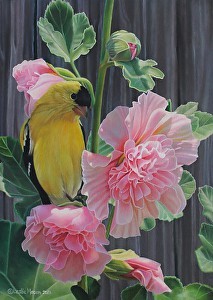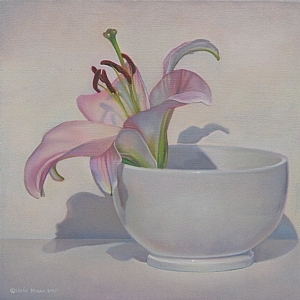Leslie Macon is an oil painter living and working in Archer Lodge, North Carolina. She started as a wood carver (fashioning decoy ducks from basswood and tupelo) and switched to wildlife painting in the early 90s. After winning some awards, she began experimenting with floral and still life. She would later branch out into historic portraits and visionary/fantasy art. She has had several collections published for the home décor market and some of her art has been made into licensed products.
I have been a huge admirer of Macon’s work for about a year now. It started with this painting:
I was smitten with “Lost in the Moment” from the moment I saw it in DailyPaintworks. I bid on it and won it, and then asked Leslie about possibly publishing it in Greenwoman Magazine. Leslie wrote back, giving me permission (it appears in our most recent issue). After learning I was a gardener who loved bees she shared the background story that she was reluctant to include in the painting’s description.
“My husband and I go to the NC mountains and stay at a cabin off of the Blue Ridge Parkway. The owners of the cabin raise honeybees and harvest honey for sale. The owner has a friend that owns a bee supply store that wanted art and crafts to sell that featured honeybees. They suggested I paint some honeybees. I love to paint bumblebees but I had never done honeybees. I have a lot of reference so I sat down and came up with three small paintings. When I did Lost in the Moment I was caught up in how enlarging my reference on my monitor took me into this magical macro world that we totally miss because the exquisite details are so small. I got caught up in the idea of being the size of a bee and rolling around in pollen on a beautiful Spring day. I also really got Georgia O’Keeffe and why she did those huge close ups of flowers. I created the painting and when I took them to the bee shop she almost cried when she looked at it. She knows a lot about honeybees and told me stories about them I never knew. She then spoke about my painting thinking that I had painted a bee dying. I was a little mortified and she explained that a honeybee knows when it will die. They leave the hive and bury themselves into a flower and die. They don’t want to die in the hive and disrupt the colony. She told me some really neat things about honeybees and I plan to paint more paintings with them. I am partial to bumblebees because I have a lot of them in my yard but honeybees really have interesting characteristics that would be cool to explore.”
Well, I have to say I was a little sad to hear the honeybee story but also skeptical. I had found a honeybee asleep in a hollyhock before (and had watched her wake up) so I didn’t really think this one was dead (although it is true that they choose flowers sometimes as their final resting place).
Either way, I found the image enchanting. I started looking at Leslie’s work regularly.
She often has a story behind the painting, as in this one, titled “Golden Opportunity”:
“I have been trying to grow hollyhocks along my back fence for years. Last year one lone hollyhock decided to sprout and grow much to my delight and amazement. The hollyhock grew quickly because it would catch the overspray of water from my garden hose each day as I filled the birdbath sitting beside it. It grew tall and flowered and became a nice perch for the goldfinches waiting for their golden opportunity to bathe. At least they had something pretty to look at while they waited their turn.”She also does floral still life paintings. I loved “Consider the Lilies.”
Corresponding with Leslie, I learned she was also a photographer. I’ve had the honor to see a few of her images, including this extraordinary one:
Here’s the story:
“The heron was fishing at the Koi pond at Duke Gardens and caught this poor koi. The heron ended up having to throw the koi back because he couldn’t swallow him. The koi was too big. You probably wouldn’t want this in your magazine because of it’s violent nature but it is a really cool photo of nature in action. The reaction of the bystanders was so funny. Everyone was mesmerized by the size and beauty of the heron at close range but horrified to see the koi being caught and possibly eaten. There was a few older ladies that were trying to shoo the heron away gently.”
(For the record – I thought this was kind of funny. Admittedly terrifying for the koi, but I couldn’t help but find it humorous that the heron was thwarted!)
This story led to me persuading Leslie to share with Flora’s Forum readers a little bit about her life as an artist who loves the garden.
FF: I find it fascinating that you started in carving. Why did you move from carving to oil painting?
Macon: There were two reasons why I quit carving. Decoy carving is sporting art and is popular with hunters and sportsman. In order to promote myself and be successful I needed to participate in events that promoted hunting. I wasn’t comfortable with that association. The second reason I quit was the lack of respect and dignity shown me by male carvers. This was back in the mid eighties and women carvers were fewer than hen’s teeth. I loved to carve decoys but I didn’t want to have to deal with the drama and negativity. I had apprenticed under a Cajun carver that had introduced me to oil paints and I just decided I would try flatwork instead.
FF: I love how you include very charming stories about your paintings on your gallery site at Paintworks! I’ve shared a few, but I would like to hear about your process of painting and how it connects to your garden.
Macon: I would probably say the garden comes first and the painting is secondary. Before any painting happens there is a moment of inspiration. It can be a simple thing that happens once like a baby mockingbird leaving his nest or it can come from a repetitious pattern that you see every time you are out doing chores like the comings and goings of a male wren collecting food for his babies. When I am in my garden my senses are in a really heightened state. I have always had telepathy with birds. I see pictures in my head and feel emotions from them that is our way of talking and communicating with each other. This is what gives me an endless supply of ideas to paint. It is actually the only reason I paint. I want to make these moments tangible and real otherwise I would just be a crazy lady that hears bird voices rattling around in her head.
FF: You have one acre of gardens on your property and many of your paintings are from your own flowers. How long have you been a gardener and what brought you to gardening?
Macon: My first memories were of gardens. My grandfather had a garden and grew all of his food. In the summer there was a circular garden in front of his house that was filled with cannas, gladiolus, dahlias, and other beautiful summer flowers. He grew some of the tallest sunflowers I have ever seen. My cousin and I would play between the rows of vegetables. Everyone in my family grew plants and had gardens so gardening has always been a true north for me. I don’t think I could exist with out it and if I could I sure wouldn’t be happy.
FF: On your Paintworks website you mention the NC State Arboretum and Duke Gardens. How do these gardens factor into your work?
Those two gardens are my Disneylands. They are my dreamworlds. My funds are limited in what I can buy and I am also limited by the size of my yard and the burden of it’s upkeep. During the Spring, Summer, and into the Fall I go to each of them at least every other week. They have master gardeners designing and tending their gardens and the beauty is beyond compare. I can see native plants but I can also see exotic plants. I take thousands of pictures as reference for my paintings. To have access to this kind of reference for my paintings is priceless. Duke Gardens is part of Duke University. They have a world class water garden that has the most beautiful koi and water lilies I have ever seen. There is no mood that can’t be fixed by a walk in Duke Gardens. It is heaven on earth.
FF: Thank you so much, Leslie! It is a delight to share your work with Greenwoman and Flora’s Forum readers!
Oh, and here’s a picture of Leslie. And, of course, links to her fabulous work – available at DailyPaintworks and her website.
I hope you’ve enjoyed reading a little bit about Leslie. One of the greatest perks of my work is getting to meet and learn about soulful, talented artists like her.
–Sandra Knauf




















